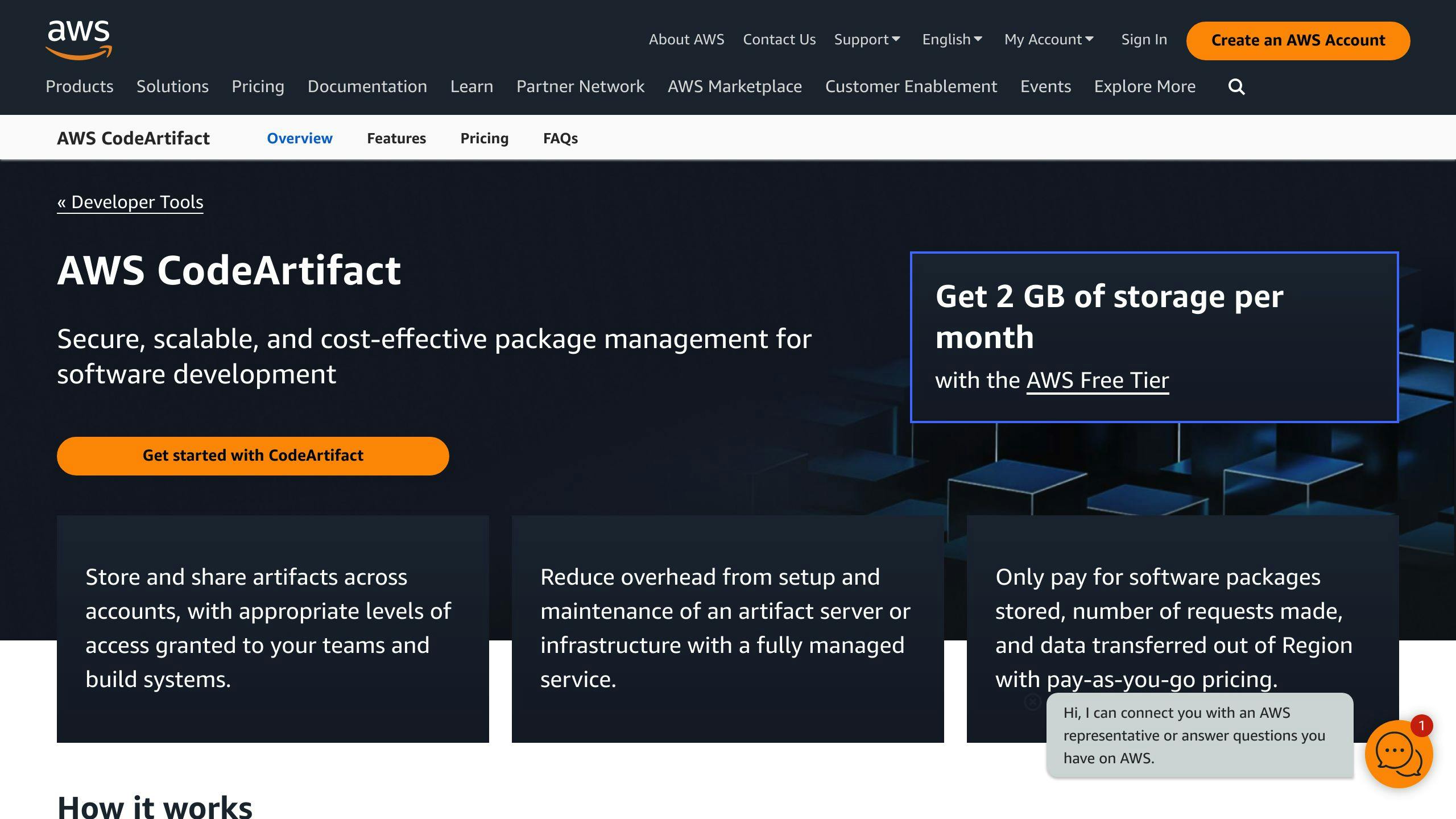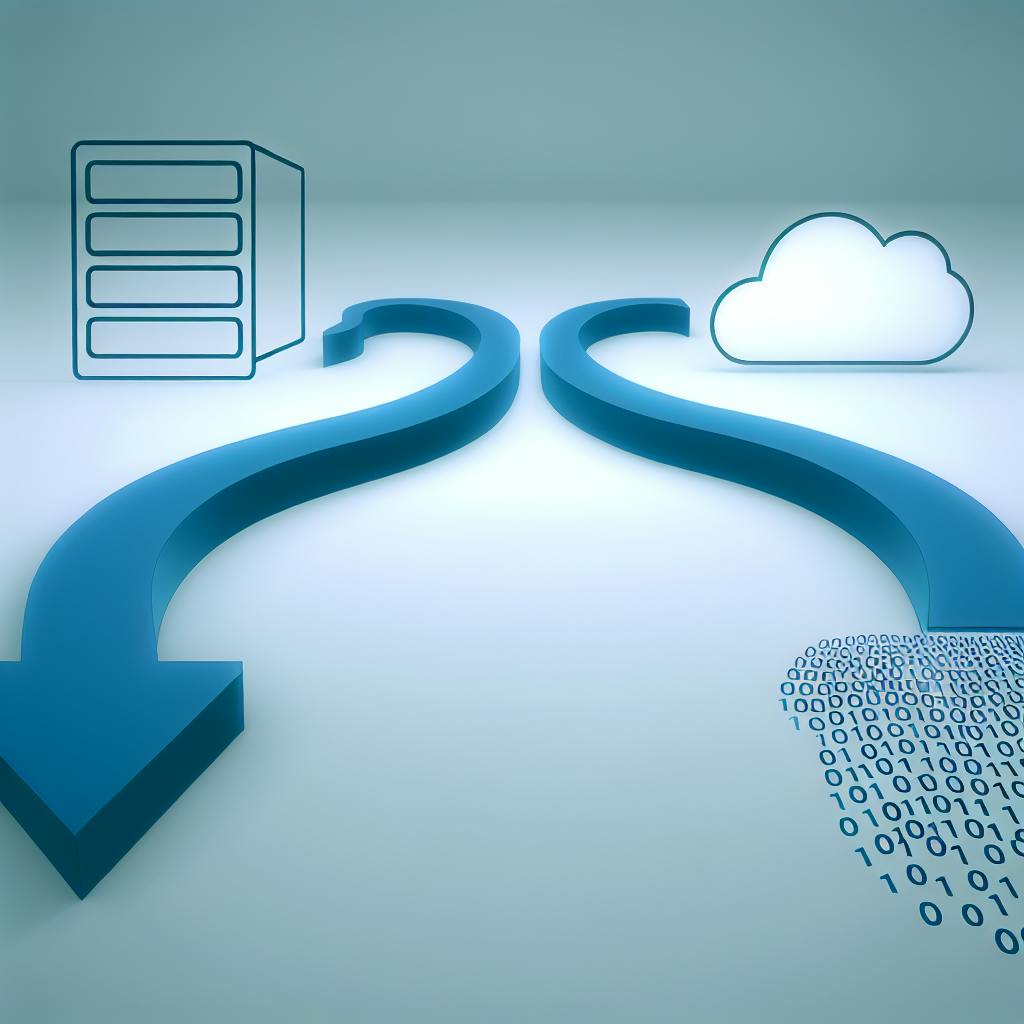AWS CodeArtifact is a fully managed service that simplifies package management for software development teams. It stores, publishes, and shares software packages, eliminating the need for setting up and maintaining infrastructure. By integrating with popular package managers and build tools, CodeArtifact streamlines handling of software dependencies and enables secure fetching of public packages within your VPC.
Key Benefits:
- Reduces overhead of managing artifact servers
- Integrates with popular tools like Maven, Gradle, npm, pip
- Provides secure and scalable artifact management
- Enables automation with Amazon EventBridge
- Ensures high availability and durability with multi-AZ and Amazon S3/DynamoDB storage
Getting Started:
- Set up an AWS account and create an IAM user with CodeArtifact access
- Create a CodeArtifact domain
- Create repositories and manage access
Pricing and Free Tier:
| Resource | Pricing |
|---|---|
| Stored packages | Pay for storage used |
| Queries made | Pay for number of queries |
| Data transfer out | Pay for data transferred out of AWS Region |
| Free Tier | 2GB storage, 100,000 requests/month |
Best Practices:
- Organize domains and repositories logically
- Secure artifacts with IAM and encryption
- Integrate CodeArtifact into development workflows
By following best practices, you can ensure efficient, secure, and scalable package management with AWS CodeArtifact.
Key Features of AWS CodeArtifact

Tool and Package Manager Integration
AWS CodeArtifact supports popular package managers and build tools, making it easy to integrate into existing development workflows. This integration enables developers to use their preferred tools, such as Maven, Gradle, npm, pip, and others, to manage software dependencies.
| Package Manager/Build Tool | Supported |
|---|---|
| Maven | |
| Gradle | |
| npm | |
| pip | |
| Others |
Secure and Scalable Artifact Management
CodeArtifact provides a secure and scalable artifact management system. It integrates with AWS Identity and Access Management (IAM) to control access to software packages, ensuring that only authorized users can access and manage packages.
Security Features:
- Encryption at rest and in transit
- Access control with AWS IAM
Automating with Amazon EventBridge

AWS CodeArtifact can be used in conjunction with Amazon EventBridge to automate package approval and other workflows. EventBridge enables developers to create event-driven architectures, allowing them to respond to changes in their software development lifecycle.
Automation Benefits:
- Automate tasks, such as package approval
- Integrate with other AWS services, such as AWS CodePipeline and AWS CodeBuild
High Availability and Durability
CodeArtifact operates in multiple Availability Zones and stores artifact data and metadata in Amazon S3 and Amazon DynamoDB. This ensures that packages are highly available and durable, even in the event of an outage.
High Availability and Durability Features:
- Multiple Availability Zones
- Storage in Amazon S3 and Amazon DynamoDB
Getting Started with AWS CodeArtifact

Setting Up AWS Account and IAM User
Before using AWS CodeArtifact, you need to set up an AWS account and configure an IAM user with the necessary permissions. If you don't have an AWS account, sign up for one on the AWS website. Once you have an account, create an IAM user with the required permissions to access CodeArtifact.
Create an IAM User:
- Log in to the AWS Management Console and navigate to the IAM dashboard.
- Click on "Users" and then click on "Create user".
- Enter a username and select "Programmatic access" as the access type.
- Attach the necessary policies to the user, such as the "CodeArtifactReadOnlyAccess" or "CodeArtifactFullAccess" policy.
- Click on "Create user" to create the IAM user.
Creating and Configuring a Domain
A domain is a CodeArtifact-specific construct that allows grouping and managing multiple CodeArtifact repositories owned by a single organization across multiple AWS accounts. To create a domain, follow these steps:
Create a Domain:
- Log in to the AWS Management Console and navigate to the CodeArtifact dashboard.
- Click on "Domains" and then click on "Create domain".
- Enter a name for your domain and select the AWS account that will own the domain.
- Choose a KMS key to encrypt your domain's artifacts. You can use an AWS managed KMS key or a KMS key that you manage.
- Click on "Create domain" to create the domain.
Managing and Using Repositories
A repository is a collection of packages and artifacts that are stored in a domain. To create a repository, follow these steps:
Create a Repository:
- Log in to the AWS Management Console and navigate to the CodeArtifact dashboard.
- Click on "Repositories" and then click on "Create repository".
- Enter a name for your repository and select the domain that you created earlier.
- Choose the package manager that you want to use, such as npm or Maven.
- Click on "Create repository" to create the repository.
Managing Repository Access:
You can manage access to your repository by specifying who has access to the repository and what level of access they have. You can grant read-only access to the repository, or you can grant write access to allow users to upload packages and artifacts to the repository.
Remember to upload packages and artifacts to your repository using the CodeArtifact console, the AWS CLI, or your preferred package manager.
Common Questions about AWS CodeArtifact
General Questions
AWS CodeArtifact is a fully managed artifact repository service that stores, publishes, and shares software packages used in development. It integrates with popular package managers and build tools like Maven, Gradle, npm, yarn, twine, and pip.
Pricing and Availability
Pricing Model:
| Resource | Pricing |
|---|---|
| Stored software packages | You only pay for the storage used |
| Number of queries made | You only pay for the number of queries made |
| Data transferred out of an AWS Region | You only pay for the data transferred out |
Free Tier:
- 2GB of storage
- 100,000 requests per month
You can estimate your costs using the AWS Pricing Calculator.
Authentication and Cross-Account Access
To authenticate to a repository from the AWS CLI:
- Install the AWS CLI and configure AWS credentials for an IAM user or role with the appropriate permission to access CodeArtifact.
- Use the CLI to call the CodeArtifact GetAuthorizationToken API, which vends auth tokens that can be included in the HTTP Authorization header in requests made by package managers and build tools.
CodeArtifact repositories support resource policies to enable cross-account access. You can add a resource policy via the console or AWS CLI.
Integrating with AWS Services
AWS CodeArtifact integrates with other AWS services, including:
- AWS CodeBuild: Use CodeArtifact as a package repository for your AWS CodeBuild projects.
- AWS CodePipeline: Integrate CodeArtifact with AWS CodePipeline to automate your continuous integration and continuous deployment (CI/CD) pipelines.
- AWS CloudFormation: Manage your artifact repositories as part of your infrastructure as code.
Troubleshooting Common Issues
If you encounter issues with CodeArtifact, check the AWS CodeArtifact documentation and troubleshooting guides for common issues and solutions. You can also contact AWS Support for further assistance. Some common issues include:
- Authentication errors
- Package upload failures
- Repository access issues
Make sure to check the CodeArtifact logs and error messages to help diagnose and resolve the issues.
sbb-itb-6210c22
Best Practices for AWS CodeArtifact
Organizing Domains and Repositories
To get the most out of AWS CodeArtifact, it's essential to organize your domains and repositories in a logical and structured way. Here are some best practices to follow:
| Best Practice | Description |
|---|---|
| Separate domains for production and development | Isolate packages for different environments |
| Individual domains per application or business unit | More isolated permissions and better organization |
| Segment experimental and stable packages | Keep packages organized and easy to manage |
| Logically group packages per application, language, or team | Easy to find and manage related packages |
| Size repositories appropriately | Contain related packages, not too big or too small |
| Set up upstream repositories | Proxy public package registries for easier access |
By following these best practices, you can ensure that your domains and repositories are organized, scalable, and secure.
Securing AWS CodeArtifact
Security is crucial when using AWS CodeArtifact. Here are some best practices to follow:
| Best Practice | Description |
|---|---|
| Use AWS IAM to control access | Control who can access your repositories and domains |
| Enable encryption | Protect your packages and repositories from unauthorized access |
| Use resource policies | Enable cross-account access to your repositories |
| Implement package-level write permissions | Control who can publish packages |
| Use Amazon CloudWatch Events | Monitor and respond to changes to your packages and repositories |
By following these best practices, you can ensure that your packages and repositories are secure and protected from unauthorized access.
Integrating into Development Workflows
AWS CodeArtifact can be easily integrated into your existing development workflows. Here are some best practices to follow:
| Best Practice | Description |
|---|---|
| Use popular package managers and build tools | Easy integration with tools like Maven, Gradle, npm, and pip |
| Integrate with CI/CD pipelines | Automate the build, test, and deployment of your packages |
| Use AWS CodeArtifact with AWS CodeBuild and AWS CodePipeline | Create a fully managed CI/CD pipeline |
| Use Amazon CloudWatch Events | Trigger automated workflows in response to changes to your packages and repositories |
By following these best practices, you can ensure that AWS CodeArtifact is seamlessly integrated into your development workflows, making it easier to manage and deploy your packages.
Conclusion
In this guide, we've explored the features and benefits of AWS CodeArtifact, a fully managed artifact repository service that simplifies package management for software development teams.
Key Takeaways
By using CodeArtifact, you can:
- Centralize your package management
- Reduce overhead and improve collaboration across teams
- Integrate with popular tools and AWS services
Best Practices
To get the most out of CodeArtifact, follow these best practices:
| Best Practice | Description |
|---|---|
| Organize domains and repositories logically | Isolate packages for different environments |
| Secure your artifacts with IAM and encryption | Protect your packages and repositories from unauthorized access |
| Integrate CodeArtifact into your development workflows | Automate package management and deployment |
By following these best practices, you can ensure that your package management and software development workflows are efficient, secure, and scalable.
Start Exploring CodeArtifact Today
With AWS CodeArtifact, you can focus on building high-quality software that meets the needs of your users. Start exploring CodeArtifact today and discover how it can simplify your package management and software development workflows.
FAQs
Why use AWS CodeArtifact?
AWS CodeArtifact is a fully managed service that stores, publishes, and shares software packages. It eliminates the need to set up and maintain infrastructure, allowing you to focus on software development.
What is a CodeArtifact package on AWS?
A package is a bundle of software and data required to resolve dependencies and launch a program. In CodeArtifact, a package consists of a package name, an optional namespace, a set of package versions, and package-level data.
Does AWS CodeArtifact support Docker?
Yes, CodeArtifact supports all major package formats, including Docker.
What is the cost of CodeArtifact?
CodeArtifact has no up-front charges or commitments. You only pay for the stored software packages, the number of queries made, and the data transferred out of an AWS Region. CodeArtifact provides a monthly free-of-charge storage and request tier.
| Resource | Pricing |
|---|---|
| Stored software packages | You only pay for the storage used |
| Number of queries made | You only pay for the number of queries made |
| Data transferred out of an AWS Region | You only pay for the data transferred out |
Free Tier:
- 2GB of storage
- 100,000 requests per month
You can estimate your costs using the AWS Pricing Calculator.


